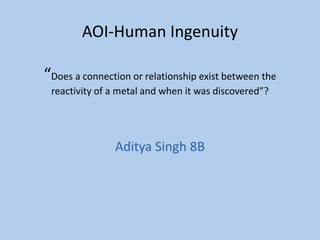One world metals
- 1. AOI-Human Ingenuityˇ°Does a connection or relationship exist between the reactivity of a metal and when it was discoveredˇ±?Aditya Singh 8B
- 2. Background InformationCurrently There are over a 100 Known Metals. Before the 19th century only 24 of these metals had been discovered and, of these 24 metals, 12 were discovered in the 18th century. Therefore, from the discovery of the first metals - gold and copper until the end of the 17th century, some 7700 years, only 12 metals were known. Four of these metals, arsenic, antimony , zinc and bismuth , were discovered in the thirteenth and fourteenth centuries, while platinum was discovered in the 16th century.
- 5. This proves to us that the metals found in the earlier centuries were far less reactive than the ones found in recent times.
- 6. Reasons to Justify My Results As time passed, more and more complex procedures of separation of metals were discovered, so more and more metals came to be known.
- 7. Examples of My Justifications.After the seven metals of antiquity: gold, silver, copper, mercury, tin , iron and lead, the next metal to be discovered was Arsenic in the 13th century by Albertus Magnus. Arsenicus (arsenious oxide) when heated with twice its weight of soap became metallic. By 1641 arsenious oxide was being reduced by charcoal.
- 8. Example 2 By 1595,bismuth was produced by reduction of the oxide with carbon , however, it was not until 1753 when bismuth was classified as an element. Zinc was known to the Chinese in 1400; however , it was not until 1738 , when William Champion patented the zinc distillation process, that zinc came into common use.
- 9. Example 3 In 1841 Charles Askin developed a method of separating cobalt and nickel when both metals are in solution. Using a quantity of bleaching powder he found that if the quantity of powder was small enough only cobalt oxide was precipitated and separated. The nickel could then be easily precipitated with lime and a source for pure cobalt and nickel was available. Pure cobalt oxide revolutionized the pottery industry as the blues were now available.
- 10. Example 4 A number of metals (Magnesium, Potassium, Aluminum etc.) could not be isolated from their compounds because they needed a complex method of separation called ˇ°Electrolysisˇ± which involved electrical energy to split them. They were only found in nature as compounds, not as elements as they are highly reactive. Therefore, these metals were discovered only when electricity was invented in the 19th century.
- 11. Bibliography:"BBC - GCSE Bitesize - Science." BBC - Homepage. Web. 13 Nov. 2010. <http://www.bbc.co.uk/schools/gcsebitesize/science/>."Boliven Patents - US5453111: Method for Separation of Metals from Waste Stream - Details." Boliven - Innovators at Work. Web. 13 Nov. 2010. <http://www.boliven.com/patent/US5453111>."History of Metals." Department of Materials Science & Engineering. Web. 13 Nov. 2010. <http://neon.mems.cmu.edu/cramb/Processing/history.html>."Revision Centre - GCSE Chemistry - Periodic Table." Revision Centre - GCSE Revision Notes and Loads More! Web. 13 Nov. 2010. <http://www.revisioncentre.co.uk/gcse/chemistry/periodic_table.html>.











